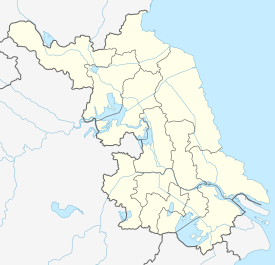Liyang
Liyang (simplified Chinese: 溧阳; traditional Chinese: 溧陽; pinyin: Lìyáng) is a county-level city under the administration of Changzhou in the Jiangsu province of the People's Republic of China. In 2011, it had a population of about 781,500. It borders the prefecture-level divisions of Wuxi to the east, Xuancheng (Anhui) to the south, and Nanjing to the west.
Liyang 溧阳市 | |
|---|---|
Nanshan bamboo forest | |
 Liyang Location in Jiangsu | |
| Coordinates: 31°25′05″N 119°22′41″E | |
| Country | People's Republic of China |
| Province | Jiangsu |
| Prefecture-level city | Changzhou |
| Area (2018)[1] | |
| • County-level city | 1,535.87 km2 (593.00 sq mi) |
| • Urban | 80 km2 (30 sq mi) |
| Population (2011) | |
| • County-level city | 781,500 |
| • Density | 510/km2 (1,300/sq mi) |
| • Urban (2018)[2] | 590,000 |
| Time zone | UTC+8 (China Standard) |
Administration
In August 1990, the PRC State Council approved the upgrade of Liyang from a county to a county-level city under the administration of the prefecture-level city of Changzhou.
Geography
Liyang has a total area of 1,535.87 square kilometres (593.00 sq mi). Liyang resides at the boundary of Jiangsu and Anhui provinces and is part of the Yangtze River Delta.
Transportation
The Nanjing–Hangzhou Passenger Railway crosses Liyang. As of 2015, several trains stop every hour at the Liyang Railway Station, which is located 5 kilometres south of downtown Liyang.[3]
Language
The dialect spoken by most people in Liyang is a Northern Wu dialect closely related to that of Changzhou, while others speak Standard Mandarin or Jianghuai Mandarin.
Sights
Tian Mu Lake inside Liyang, is a popular tourist area featuring the lake, resorts, and famous fish head soup. Nanshan Bamboo Sea is another tourist site with great views of bamboo trees all over the hills. It is also an artificial lake.
Notable people
- Wu Yun Dong, theoretical organic chemist
Twin cities
- Leeuwarden, Netherlands (since 2011)
References
- Cox, W (2018). Demographia World Urban Areas. 14th Annual Edition (PDF). St. Louis: Demographia. p. 22.
- Cox, W (2018). Demographia World Urban Areas. 14th Annual Edition (PDF). St. Louis: Demographia. p. 22.
- Liyang train schedule (in Chinese)